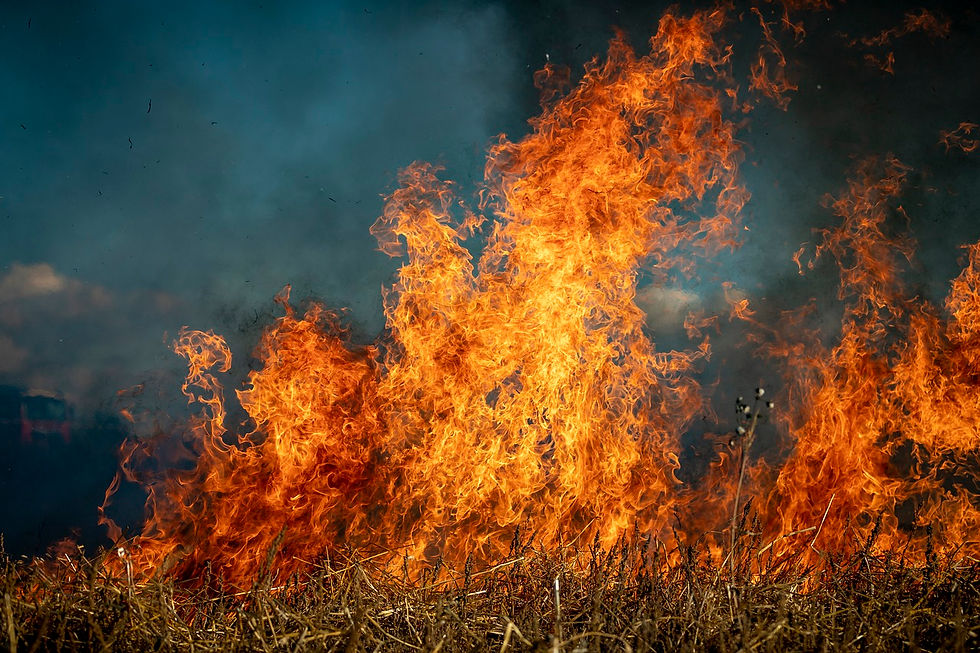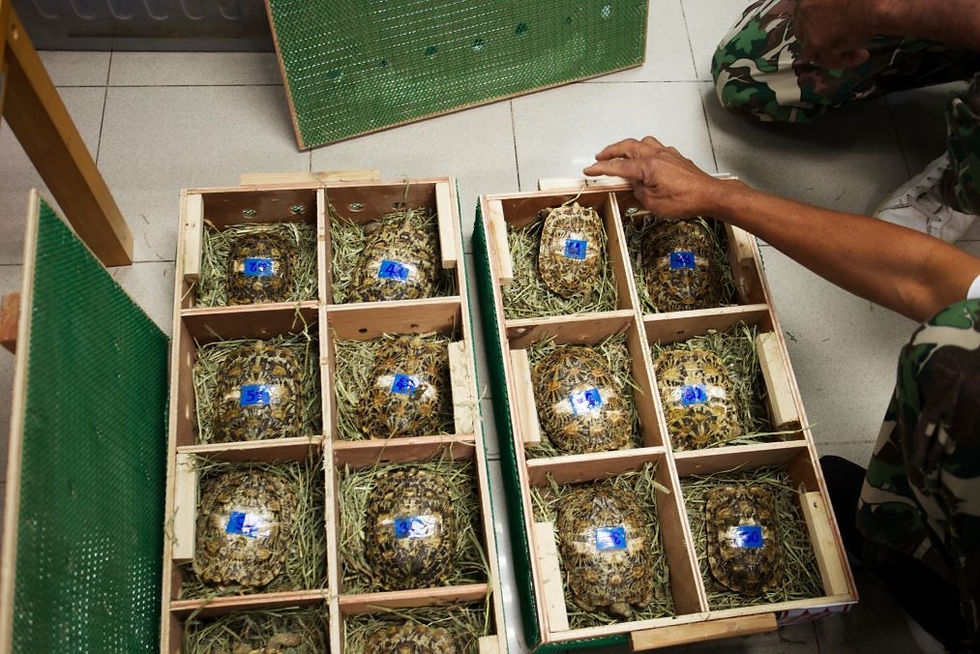Protecting Animals and Livelihoods: Are We Prepared for Wildfires?
- Brenda Karimi
- Feb 14
- 6 min read
Updated: Mar 13
Across Kenya and the world, wildfires are becoming more frequent, more intense, and more devastating. The recent wildfire in Isiolo, which raged for 9 days as from January 17, destroyed nearly 600,000 acres of grazing land in Merti, with the biggest blaze starting in Malkagalla and another in Chaffa.
These fires were reportedly caused by herders attempting to combat tick infestations by burning grasslands. The fires devastated critical grazing areas, threatening the survival of livestock and the livelihoods of pastoralist communities.
Farmers in Isiolo have been hit hard, losing their main source of income and survival. Unfortunately, locals tried to stop the fire but it was difficult due to a lack of proper tools. From this unfortunate incident, it’s clear Kenya needs better plans and more support to fight these fires and protect its people and their animals.
As climate change accelerates, the frequency and intensity of wildfires are expected to rise, posing significant threats to wildlife, livestock, and companion animals.

The Impact of Wildfires on Animals and Livelihoods
Livestock and Farming Communities
Agriculture, especially livestock farming, is a huge part of the economy, making up 24% of the country’s GDP and bringing in 60% of export earnings. But wildfires are putting everything at risk. In Isiolo County alone, over 600,000 acres of grazing land have gone up in flames, leaving herders struggling to find food and water for their animals. This takes a toll on the animals, making them weak and prone to diseases.
Wildlife
Wildfires devastate wildlife by destroying habitats and forcing animals to flee in search of food, water, and shelter. This displacement threatens biodiversity and increases human-wildlife conflict. Recovering ecosystems takes years, as the loss of key species disrupts entire food chains. With climate change fueling wildfires, protecting wildlife and restoring habitats are crucial for biodiversity and environmental sustainability.
Companion Animals and Urban Settings
Pet owners in wildfire-prone areas face major challenges evacuating their animals, with limited access to pet-friendly shelters and inadequate emergency response plans. Many are forced to leave pets behind due to transportation issues, shelter restrictions, or lack of resources, leading to heartbreaking separations and loss. The stress of wildfires affects both pets and owners, causing anxiety, and pet health issues from smoke exposure and chaotic evacuation conditions.
Who Oversees Animal Disaster Management in Kenya?
Animal emergencies in Kenya are managed by the Directorate of Veterinary Services, under the Ministry of Agriculture and Livestock Development with support from national institutions such as:
Kenya Wildlife Service (KWS): Responsible for conserving and managing wildlife in Kenya. It coordinates rescue operations for wild animals during disasters.
Kenya Forest Service (KFS): Manages forest ecosystems, that directly impact wildlife, and responds to wildfires that threaten animals and habitats.
National Disaster Management Unit (NDMU): Established in 2013, it coordinates disaster response through a structured command system, budget and standard operated procedures (SOPs), aligning with Vision 2030 to enhance national safety and resilience.
National Drought Management Authority (NDMA), is a public body established by the National Drought Management Authority (NDMA) Act, 2016. The Act mandates the NDMA to coordinate all drought management efforts, including the implementation of related policies and programs.
Non-Governmental Organisations (NGOs) such as the Kenya Red Cross and the Kenya Society For The Protection & Care Of Animals – KSPCA.
Legal and Policy Framework
Wildlife Conservation and Management Act, 2013
The Wildlife Conservation and Management Act, 2013 empowers the Kenya Wildlife Service (KWS) to address emergencies affecting wildlife. The Act also promotes habitat restoration, climate adaptation measures, and wildlife disease surveillance to mitigate disaster impacts. Additionally, it establishes a Wildlife Compensation Scheme to support communities affected by wildlife-related damages, particularly during extreme weather events.
Forest Conservation and Management Act, 2016
The Act mandates the Kenya Forest Service (KFS) to manage wildfires in forests which are key wildlife habitats. it also criminalizes starting uncontrolled fires in forested areas and establishes community forest associations (CFAs) to assist in fire prevention.
National Drought Management Authority (NDMA) Act, 2016
The National Drought Management Authority (NDMA) Act, 2016 authorizes the NDMA to coordinate drought risk management in Kenya. It mandates early warning systems, contingency planning, and drought response integration into development programs. The Act also provides for research, climate adaptation strategies, and the National Drought Emergency Fund to support mitigation efforts.
National Disaster Risk Management (DRM) Policy (2017)
The DRM policy focuses on reducing the risks of both natural and human-made disasters and their impact on people, the economy, and the environment at the National and County levels through a multi-hazard approach.
Policy Objective 4 aims to strengthen resilience to disaster risks and climate change at all levels. It encourages communities to act early to reduce risks, moving from just responding to disasters to preventing them. One key focus is protecting important assets like livestock, animals, tools, and seeds to help communities recover and keep their livelihoods safe during disasters.
The policy aligns with national and global development goals, including the UN Sendai Framework for Disaster Risk Reduction, which aims to substantially reduce disaster risk and losses in lives, livelihoods, and health.
National Wildlife Conservation and Management Policy, 2020
The Wildlife Policy 2020 emphasizes disaster preparedness to protect wildlife from threats like wildfires, floods, disease outbreaks, and human-wildlife conflicts. It strengthens early warning systems, enhances wildlife disease surveillance, and promotes biosecurity measures to prevent zoonotic disease outbreaks. It also establishes fire management protocols, community-based conservation programs, and emergency response plans to mitigate disasters.
Veterinary Policy (Sessional Paper No. 2 of 2020)
The Veterinary Policy, 2020 integrates disaster response by strengthening animal health, disease control, and emergency preparedness during crises like droughts, floods, disease outbreaks, and wildfires. It emphasizes early warning systems, rapid veterinary response teams, and biosecurity measures to prevent and contain the spread of zoonotic and transboundary diseases. The policy also promotes vaccination programs, emergency veterinary services, and livestock feed reserves to safeguard animal health and livelihoods during disasters.
Livestock Policy (Sessional Paper No. 3 of 2020)
The Livestock Policy, 2020 promotes enhancing emergency response mechanisms, and supporting vaccination programs for transboundary livestock diseases. It promotes drought-resistant livestock breeds, strategic fodder reserves, and sustainable rangeland management to improve resilience. The policy also emphasizes fire safety standards for livestock shelters, community awareness programs, and rapid response units for disease control.
National Agricultural Insurance Policy (NAIP) 2024
The NAIP Policy 2024 helps farmers and livestock keepers recover from disasters while promoting resilience. The policy provides insurance coverage for climate-related losses, ensuring farmers affected by wildfires, drought, or flooding receive financial support to rebuild. It also protects livestock keepers by covering losses due to disease outbreaks, wildlife attacks, and pasture destruction.
National Wildlife Strategy (2030)
The National Wildlife Strategy 2030 prioritizes climate change resilience and disaster preparedness to protect wildlife from extreme weather events such as droughts, wildfires, and floods. These disasters threaten ecosystems, disrupt migration patterns, and increase human-wildlife conflict.
The strategy emphasizes fire surveillance systems, early warning mechanisms, and rapid response teams to detect and contain wildfires. This includes community training, controlled burns, and firebreaks to minimize damage.
Challenges
Overlapping Responsibilities & Unclear Roles
Various government departments and agencies have conflicting or overlapping responsibilities in disaster management. It is unclear which organization should take the lead when animals are affected by disasters such as wildfires, floods, or droughts. This results in duplicated efforts, wasted resources, and delayed action.
Limited Community Involvement & Training
Many local communities are unprepared for disasters, as they lack training in animal evacuation, emergency response, and fire control. Indigenous knowledge is often ignored in disaster preparedness plans. There is no structured early warning system for communities that rely on livestock and wildlife-based livelihoods. A stronger focus on community-based disaster preparedness would enhance resilience and response capacity.
Weak Policy Implementation & Enforcement
Laws and policies related to animal disaster management, but their implementation is often weak. There is a need for clear policies outlining responsibilities, funding, and emergency protocols for responding to disasters affecting animals.
Inadequate Resources
Kenya lacks sufficient funding for animal disaster management. Many counties do not have dedicated emergency response teams for animals. There is a shortage of firefighting equipment, veterinary emergency services, trained personnel, and evacuation centres for wildlife and livestock.
In rural areas, communities often rely on their limited resources to handle disasters, leading to significant losses.
Absence of a Unified Command Structure
Without a unified command structure, disaster response remains fragmented. Wildlife, livestock, and domestic animals often suffer as a result of delayed or uncoordinated interventions. A single coordinating agency could ensure a faster, more organized, and well-resourced response.
The Future of Animal Disaster Management in Kenya
If we are to truly honor our responsibility to the animals with whom we share this planet, we must ensure their protection in times of crisis. Animals suffer greatly during disasters, be it droughts, floods, or wildfires.
To build a more effective response, we must:
🌿Strengthen policies – Animals must not be forgotten in disaster management laws. Their welfare should be a fundamental consideration.
🌿Secure sustainable funding – Dedicated resources, including emergency funds and insurance options, will ensure swift action when disasters strike.
🌿Engage communities – The people who live alongside animals; farmers, herders, and conservationists must be empowered to take part in disaster preparedness and response.
🌿Invest in training – More veterinary professionals, equipped with the skills and resources they need, will be essential in safeguarding animal lives.
Every action makes a difference. Animals deserve a future where they are no longer left to suffer in times of crisis.
More work needs to be done. By strengthening policies, funding, and coordination, Kenya can serve as a model for other African countries in safeguarding animals and livelihoods during crises.



Comments